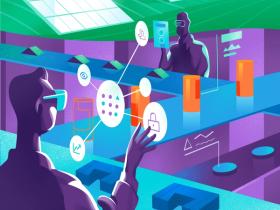IoT in Logistics & Transportation
Published: May 2, 2022
12 min read
In this article, you'll learn:
1
🧱 5 Layers of IoT in the Transportation Industry
2
📈 Benefits of using IoT in Logistics & Transportation
3
🚛 IoT Use Cases in the Logistics Industry
4
🔧 IoT Challenges in Logistics Processes
5
💡 Takeaways
Let’s now find out what are the key benefits of adopting IoT in the logistics and transportation industry, along with the main use cases and challenges that companies may encounter in the supply chain process.
🧱 5 Layers of IoT in the Transportation Industry
An IoT architecture in transportation presents 5 operational layers to set up a trustworthy system of goods shipment. These are:
- an application layer;
- a service layer;
- a sensing layer;
- a communication layer;
- and an infrastructure one.
Every piece of data requires proper communication to be delivered right into the service layer after being sensed and stored in an infrastructure layer. For a better understanding of the Internet of Things architecture in the transportation cycle, let’s have a brief acquaintance with these layers and their responsibilities:
- Environment. Various sensors that transmit data in real-time grant flexibility in avoiding congestion and quick adaptation to sudden traffic pattern changes. Exactly the reduction of congestion and lesser energy waste because of quick reaction to new traffic patterns shows a great impact on the environment.
- Safety. IoT in logistics provides better security for employees in terms of fast issue detection. In case of an unexpected equipment issue, IoT sensors will notice it and react much faster, which can grant additional employee safety. For example, it doesn’t only provide real-time quality monitoring, it also may be programmed to automatically call an ambulance whenever sensors detect an emergency.
🚛 IoT Use Cases in the Logistics Industry
Now that we are more familiar with the general advantages of adopting IoT in logistics and transportation, let’s see how it can be specifically implemented in different use cases.
Inventory Tracking
Thanks to IoT systems, it’s easier to monitor the safety of goods as well as quickly locate required products across gigantic warehouses. Inventory tracking also minimizes human-storage interactions which affects the number of possible inaccuracies.
The most popular use for such smart labels comes when the goods require special conditions to be maintained for quality delivery. For example, constant monitoring of frozen edible goods helps to prevent company losses in case of unexpected malfunction during transportation services.
Also, by using the smart tags, logistics companies may even reduce financial damage from the goods being stolen, as labels’ GPS tracking capacities may become quite handy.
As an example, there is a case study that covers the implementation of IoT-CMS in AOC Limited that covers the cold chain logistics with Chevalier Cold Storage and Logistics Limited in Hong Kong. In a four-stage system implementation and a 10-day data gathering, AOC Limited became able to monitor cargo conditions along with providing quality storing in real-time.
Drone Based Delivery
Among all the IoT solutions for supply chains, adopting drones for the transportation process has the greatest potential. As timely delivery is a top priority, minimizing human and route factors with IoT technologies will definitely be beneficial. Drone-based delivery not only makes route optimization strategies easier but also significantly reduces operating costs for the service provider. Transportation IoT technologies such as drones are not yet ready for a complete adoption, however, some loud announcements have already been made.
So Amazon is already making progress in the eventual release of drone-based deliveries, and in the nearest future, we will see the beginning of the revolution in the transportation and logistics sector.
🔧 IoT Challenges in Logistics Processes
According to the Internet of things and its challenges in supply chain management research, adopting IoT comes with some challenges. Let’s take a look at the ones related to the supply chain process along with the issues that you shouldn’t ignore.
Integration
When we consider various potential challenges the first category to think of is definitely the integration part. What are the issues specifically related to integrating IoT features that shouldn’t be missed? Let’s find out the main ones.
- Scalability. As the smart devices in the supply chain will mostly serve a specific purpose it will lead to them being customized and set up exactly for the clear-cut usage in particular cases. It should be clear that with most of the possible customizations, there is a high risk of IoT being unscalable in the supply chain as well as the chances for device reusage in some diverse use cases considerably lower.
- Business model modifications. As we are talking about integrating IoT features into an already existing and functioning business, it’s vital for the chosen model to be suitable for such adoption. It is crucial that every component of the existing supply chain (manufacturers, suppliers, and distributors) can fit into the new business model and not be in disfunction. Or there is a risk that a previous business model will be no longer applicable to cover up the consequences of such an experiment.
- Financial awareness. IoT adoption without a doubt is a significant upgrade for a company, however, everything has its own price. It may be very challenging financially for many logistics companies to implement IoT features they are hugely expecting in their supply chain business. So taking such an important step without the realization of potential operational costs required may be very damaging to a company’s prosperity.
Operational
This section of challenges consists of the issues related to operational processes. What points should be considered in order to set up the highest functioning level and what usually stops the successful adoption of IoT in logistics industries.
- Weak planning stages. As IoT is a relatively new technology for companies to adopt, seeking expert IoT app development services can provide the necessary support and expertise for its integration. Unfortunately, it’s not enough to just realize the importance of IoT for a logistics business. Then there should always come thorough research and a clear strategy on how to adopt IoT properly and adapt it in the most beneficial way for a company. Nowadays, the lack of knowledge in IoT and consequent weak planning stages prevent many companies from accessing the benefits of IoT.
- Security and privacy issues. Successful IoT integration is impossible without setting up proper security levels. As cyber intrusions and data leaks may cause severe damage to a company both financially and reputationally, security should be considered the top priority.
- Storage management. This challenge is partially related to the energy consumption issue we mentioned before. Logistics IoT devices generate a lot of information that should be stored properly in order to be practically convenient for use and presentation. The means of storing the big amount of generated data also require power for proper function, which should also be considered before integrating smart devices.
Social
Challenges that come with IoT are not only about operational or integration issues. It’s important to be aware of the challenges that involve social interactions such as gaining trust or re-educating employees. Let’s take a deeper look at them.
- Establishing Trustworthiness. Whenever a company decides to adopt the IoT, it often becomes necessary either to hire additional employees or to train some of them to be competent enough. In any of these cases, it becomes vital to gain trust among the stakeholders as well as to reach a complete agreement for the Internet of Things adoption. If a bigger percentage of them don’t have any idea how things operate with IoT, it may take some time to get their understanding. Unaware parties should trust the process and be confident about the positive outcome of implementing an IoT technology they have no clue about.
- **Constant Environmental Variability. **Although environmental challenges are also presented separately on the list, this challenge is not about ecology. The point is that almost everything in our world is dynamic. Whether it’s changing technologies or user behavior — nothing is absolutely stable and thus can’t be easily predicted. That’s why Internet of Things implementation involves adopting constant updating and adaptation to keep up pace with the environmental dynamics.
Environmental
After describing technical and social challenges we should also consider environmental awareness and the issues that lay beyond it. When it comes to the environment there are several challenges.
- Energy Issues. Nowadays the number of created smart devices continues to rise rapidly. Thus, there are also increases in the amount of energy required to power them. Although the whole world is looking forward to fully ecological power consumption, renewable energy sources may not be enough to fulfill the new power demands. Implementing a big number of smart devices may require a step back to traditional energy sources, which hugely affects the ecology.
- E-Waste. The more Internet of Things devices are manufactured the more technological disposals there will be. Basically, whenever an IoT device substitutes another gadget in a system — the e-waste rate increases. The disposal of various machinery and peripherals should be thoroughly considered with the adoption of the Internet of Things.
💡 Takeaways
In conclusion, we can confidently state that adopting the Internet of Things for Logistics and Transportation businesses is significantly beneficial to improving safety, profit, and reliability. The number of possible use cases for IoT systems is game-changing, and shouldn’t be underestimated. If you choose a prosperity course for your logistics or transportation project — implementing IoT is definitely the most beneficial and reliable step you can take.
If you have any questions or need help with integrating IoT features into your logistics or transportation project, let us know. We will be happy to help you meet your business needs with an outstanding product!
Was it helpful?
Read also

What is Prototyping in IoT and Some Practical Advice

What is IoT Device Management?

How to Make your React Native Application Accessible to ALL, not just to MANY
Our clients say
![Stormotion client Alexander Wolff, CPO from [object Object]](/static/a16ba3c9580effc3ab9a68d115eadffe/b0e74/alex.png)
When I was working with Stormotion, I forgot they were an external agency. They put such effort into my product it might as well have been their own. I’ve never worked with such a client-focused company before.
Alexander Wolff, CPO
Sjut
